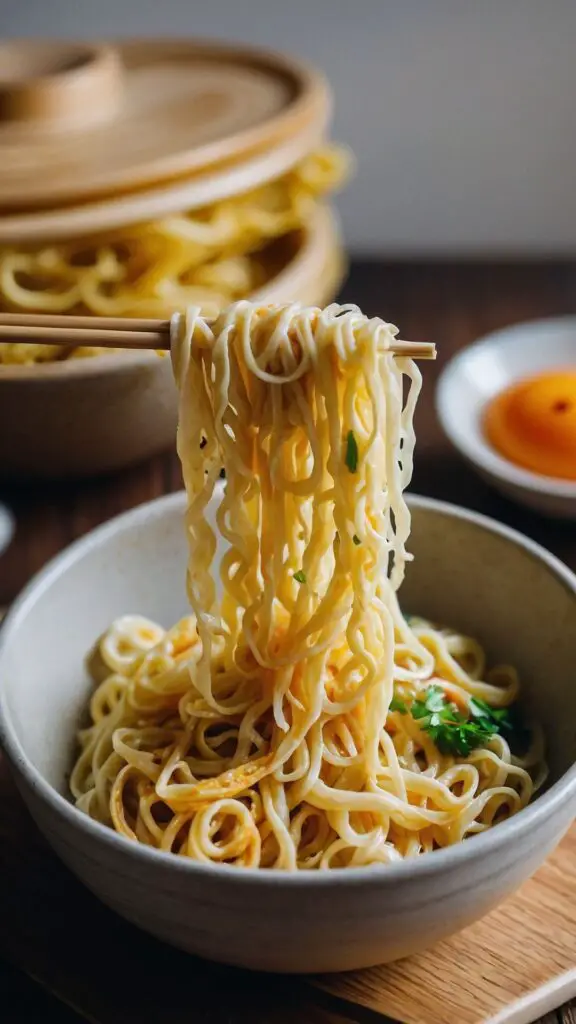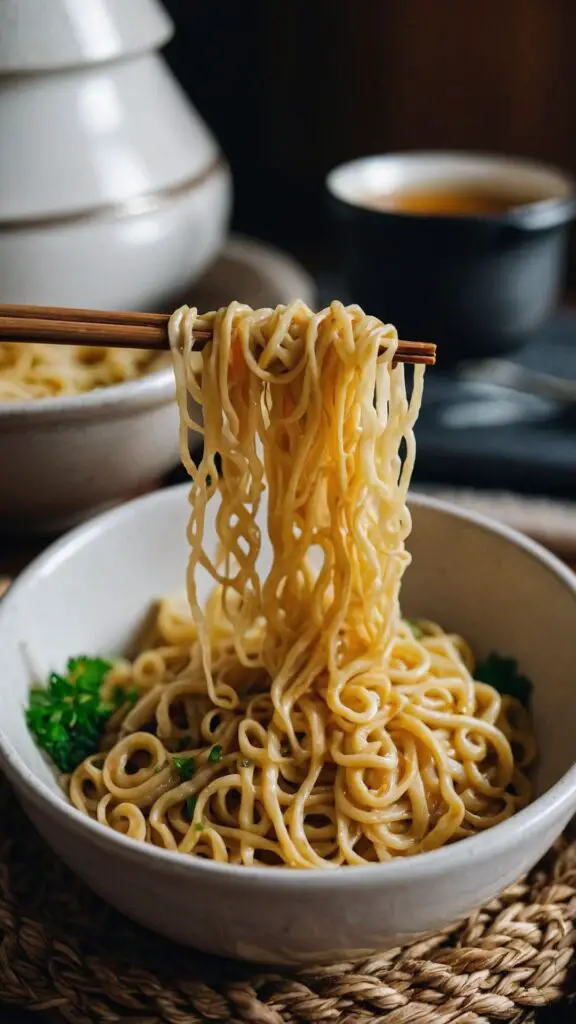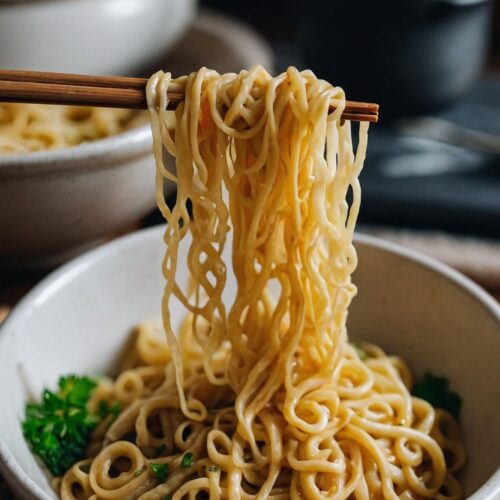Homemade Chinese Egg Noodles Recipe – Culinary Chase
There’s something about homemade Chinese egg noodles that makes my heart flutter. Beyond their delightful chewiness and versatility, these noodles can pair with a variety of dishes. From stir-fries to soupy creations, they harmonize beautifully with flavors ranging from sweet to savory and everything in between. Imagine twirling them around your fork, only to be met with the comforting embrace of tender vegetables and rich sauces. It’s love at first bite.
In this blog, I’m thrilled to unravel the steps to make these authentic delicacies right in your kitchen. Get ready for a fun and informative journey into the world of egg noodles!

When I first delved into homemade Chinese egg noodles, I was amazed. Not only were they delicious, but the process was surprisingly simple. As a food enthusiast and dietitian who shares quick healthy recipes, I can attest to the joy of cooking from scratch. There’s a kind of magic in crafting something with your own two hands. Plus, I promise these noodles will elevate your meals to a whole new level of satisfaction.
What Are Homemade Chinese Egg Noodles?
Homemade Chinese egg noodles are a staple in many Asian dishes. They are made from eggs and flour, giving them a rich flavor and a delightful texture. Unlike their dried counterparts, homemade versions boast a softness that simply begs to be soaked in sauces or tossed in stir-fries.
With a little bit of time and your favorite ingredients, you can create a batch of these delectable noodles. They also keep well, allowing you to use them in various meals throughout the week. There’s honestly nothing quite like it!
You will also like the following Side Dishes recipes!
- Smashed Asian Cucumber Salad
- Taiwanese Beef Noodle Soup In Instant Pot
- How to make Shrimp And Broccoli Recipe
Why This Recipe Works
The beauty of making homemade egg noodles is in the simplicity of the ingredients used. This recipe focuses on three elements: flour, eggs, and salt, harmonizing perfectly to create a balanced dough. The inclusion of fresh eggs adds protein and depth, while the flour gives the noodles structure and chewiness.
The method is straightforward yet effective. You don’t need fancy equipment—just some elbow grease, a rolling pin, and a good knife. Winged with a few tips and tricks, you’ll be whipping up these noodles like a pro in no time.
What You’ll Need to Make This Dish?
Preparation is key, so gather your ingredients first. For this egg noodle recipe, you’ll need the following:
- 2 cups plain all-purpose flour: This is the base that will form the structure of your noodles.
- 3 large free-range eggs: These are crucial. They provide flavor and texture.
- 1 teaspoon vanilla extract: While not typical in savory dishes, it can add an interesting undertone.
- 1/2 teaspoon fine sea salt: Essential for seasoning your dough.
- 1 tablespoon cold filtered water: This can help with dough consistency if needed.
Now that you have your arsenal ready, let’s create some homemade goodness!

How to Make Homemade Chinese Egg Noodles?
Making your own Chinese egg noodles is simpler than you might think. Here’s a brief overview of the process. We will dive into the detailed steps afterward.
- Prepare your dough by mixing flour, eggs, and salt.
- Knead the mixture until smooth.
- Roll out the dough and cut it into your preferred noodle shape.
- Allow the noodles to dry slightly before cooking.
Simple, right? Let’s break it down in a detailed, step-by-step approach.
Step 1: Mixing the Dough
In a large mixing bowl, combine the flour and salt. Make a well in the center and crack the eggs inside. Use how many eggs depends on how rich you want your noodles. Now, using a fork, start whisking the eggs gradually incorporating the flour from the edges.
Step 2: Kneading the Dough
Once the dough begins to come together, transfer it onto a floured surface. Knead it for about 8 to 10 minutes. This step is vital; it develops the gluten, which contributes to the texture. You want a smooth, elastic dough. If it feels too dry, add a bit of the cold filtered water.
Step 3: Rolling Out the Dough
Now comes the fun part! Divide the dough into manageable sections. Using a rolling pin, roll each section out to about 1/8 inch thickness. Be sure to dust with flour to prevent sticking. If you’re feeling extra adventurous, try to roll it as thin as possible for delicate noodles.
Step 4: Cutting the Noodles
Once rolled, use a sharp knife or pizza cutter to slice the dough into your desired noodle width. Whether you prefer wide or narrow noodles, this is your canvas. Dust the cut noodles with flour to keep them from clumping.
Step 5: Drying the Noodles
Allow your freshly cut noodles to sit for about 30 minutes. This step helps them firm up and becomes the perfect vehicle for your favorite sauces.
Step 6: Cooking the Noodles
Cook the noodles in a pot of boiling salted water. Fresh noodles will cook in about 2 to 4 minutes. Don’t forget to taste test. Once done, drain and rinse in cool water to stop the cooking process.
Tips for Perfect Noodles
- Quality of eggs matters: Fresh, free-range eggs yield better flavor.
- Don’t rush the kneading process: This critical step develops the noodles’ texture.
- Use enough flour: Always dust your surfaces with flour to prevent sticking.
- Experiment with thickness: If you enjoy varied textures, try rolling your dough to different thicknesses.
- Tweak the consistency with water: If the dough is tough, a tiny bit of cold filtered water can make a difference.
How to Store Leftovers?
If you find yourself with extra noodles, do not worry! Store them in an airtight container. They will last about 2 to 3 days in the refrigerator. You can also freeze them for longer storage—just layer them between parchment paper to prevent sticking and freeze for up to a month.
Nutrition Information
Homemade Chinese egg noodles pack a good nutritional punch. Here’s a breakdown for a typical serving:
Of course, the actual numbers can vary depending on portion size and whether you serve them with rich sauces or veggies.
How would I recommend serving homemade Chinese egg noodles?
Serving homemade egg noodles allows for endless creativity. Here are some of my top suggestions:
- 1. Stir-Fried Noodles: Toss your noodles with a medley of veggies and sauce. My favorite combination includes bell peppers, carrots, and snap peas sautéed in soy sauce and sesame oil. The result? A symphony of flavors that’ll leave you craving more!
- 2. Noodle Soup: Add your homemade noodles to a flavorful broth. I love a simple chicken or vegetable broth infused with ginger and garlic, topped with green onions and cilantro for that extra zing.
- 3. Cold Noodle Salad: After cooking, rinse the noodles in cold water. Toss with sesame oil, soy sauce, and a handful of shredded veggies. Add a sprinkle of sesame seeds, and you have a refreshing dish that’s perfect for meal prep or casual gatherings.
- 4. Noodles with Stirred Egg and Greens: Beat some eggs and add them to the wok after your noodles are cooked. Toss in some spinach or bok choy for nourishment, and season simply with soy sauce or oyster sauce.

What Alternatives Can You Use for the Ingredients if Not Available?
Sometimes, you might not have everything on hand. Here are some alternatives:
- 1. Whole Wheat Flour: If plain all-purpose flour isn’t available, try whole wheat flour for a nuttier flavor and more fiber. You might need a bit more liquid, so adjust accordingly.
- 2. Egg Replacement: For a vegan version, use flax or chia seeds. Mix 1 tablespoon of ground seeds with 2.5 tablespoons of water to replace one egg. Keep in mind, the texture will differ slightly.
- 3. Salt Substitutes: If you need to cut back on sodium, consider using salt substitutes or flavored herbs to season your dough.
- 4. Different Noodles: If you’re looking for convenience, you can opt for store-bought fresh noodles. Just remember to follow cooking times closely, as they can vary.

Homemade Chinese Egg Noodles Recipe
Equipment
- A pasta roller
- sauce pan
Ingredients
- 2 cups plain all-purpose flour
- 3 large free-range eggs
- 1 teaspoon vanilla extract
- 1/2 teaspoon fine sea salt
- 1 tablespoon cold filtered water
Instructions
Step 1: Mixing the Dough
- In a large mixing bowl, combine the flour and salt. Make a well in the center and crack the eggs inside. Use how many eggs depends on how rich you want your noodles. Now, using a fork, start whisking the eggs gradually incorporating the flour from the edges.
Step 2: Kneading the Dough
- Once the dough begins to come together, transfer it onto a floured surface. Knead it for about 8 to 10 minutes. This step is vital; it develops the gluten, which contributes to the texture. You want a smooth, elastic dough. If it feels too dry, add a bit of the cold filtered water.
Step 3: Rolling Out the Dough
- Now comes the fun part! Divide the dough into manageable sections. Using a rolling pin, roll each section out to about 1/8 inch thickness. Be sure to dust with flour to prevent sticking. If you’re feeling extra adventurous, try to roll it as thin as possible for delicate noodles.
Step 4: Cutting the Noodles
- Once rolled, use a sharp knife or pizza cutter to slice the dough into your desired noodle width. Whether you prefer wide or narrow noodles, this is your canvas. Dust the cut noodles with flour to keep them from clumping.
Step 5: Drying the Noodles
- Allow your freshly cut noodles to sit for about 30 minutes. This step helps them firm up and becomes the perfect vehicle for your favorite sauces.
Step 6: Cooking the Noodles
- Cook the noodles in a pot of boiling salted water. Fresh noodles will cook in about 2 to 4 minutes. Don’t forget to taste test. Once done, drain and rinse in cool water to stop the cooking process.
Notes
- Quality of eggs matters: Fresh, free-range eggs yield better flavor.
- Don’t rush the kneading process: This critical step develops the noodles’ texture.
- Use enough flour: Always dust your surfaces with flour to prevent sticking.
- Experiment with thickness: If you enjoy varied textures, try rolling your dough to different thicknesses.
- Tweak the consistency with water: If the dough is tough, a tiny bit of cold filtered water can make a difference.
Nutrition
Frequently Asked Questions
Can I use gluten-free flour for egg noodles?
Yes! Gluten-free flour can be used, but the texture will be different. Experiment with a blend to find the combination that works best for you.
Do I need a pasta machine?
A pasta machine can help, but it’s not necessary. A rolling pin and a sharp knife will do just fine.
How long will the homemade noodles last?
Fresh noodles can stay good in the fridge for 2-3 days. If you freeze them, they’ll last about a month.
Can I add spinach to the dough?
Absolutely! Puree cooked spinach and incorporate it into your dough. This adds flavor, color, and nutrients.
What sauces pair best with these noodles?
Soy sauce, garlic sauce, or even peanut sauce are excellent choices that bring out the noodles’ texture and flavors.
Can I make these noodles ahead of time?
Yes! You can prepare the dough and store it in the fridge for up to 24 hours before rolling and cooking.
Conclusion
Homemade Chinese egg noodles are not just a meal; they represent a culinary adventure. Crafting them from scratch allows you to develop skills in the kitchen while creating something that truly feels homemade. Whether you are enjoying them in a stir-fry or a comforting soup, these noodles will undoubtedly impress your family and friends. Plus, the satisfaction of knowing you made them by hand? Priceless. So gear up, gather your ingredients, and let’s get cooking. Your taste buds will thank you!
